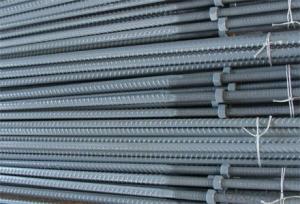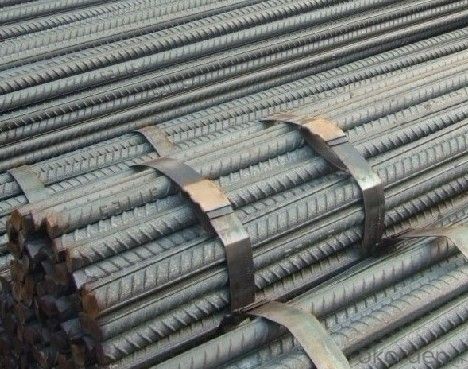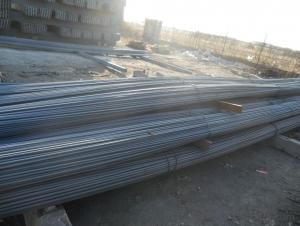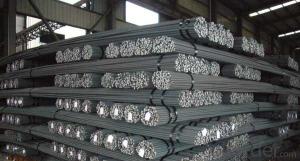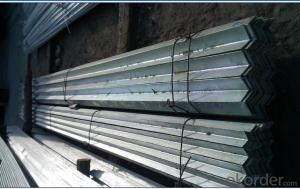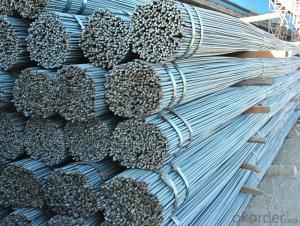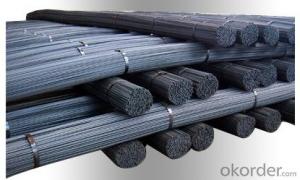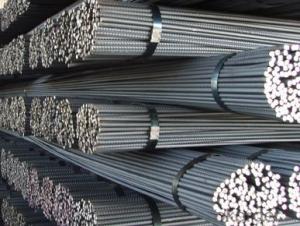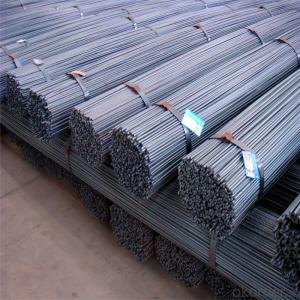GR40 deformed steel bar bar for construction
- Loading Port:
- Tianjin
- Payment Terms:
- TT OR LC
- Min Order Qty:
- 10000 m.t.
- Supply Capability:
- 100000 m.t./month
OKorder Service Pledge
OKorder Financial Service
You Might Also Like
Specification
OKorder is offering high quality GR40 deformed steel bar bar for construction at great prices with worldwide shipping. Our supplier is a world-class manufacturer of steel, with our products utilized the world over. OKorder annually supplies products to European, North American and Asian markets. We provide quotations within 24 hours of receiving an inquiry and guarantee competitive prices.
Product Applications:
GR40 deformed steel bar bar for construction for construction for construction are ideal for structural applications and are widely used in the construction of buildings and bridges, and the manufacturing, petrochemical, and transportation industries.
Product Advantages:
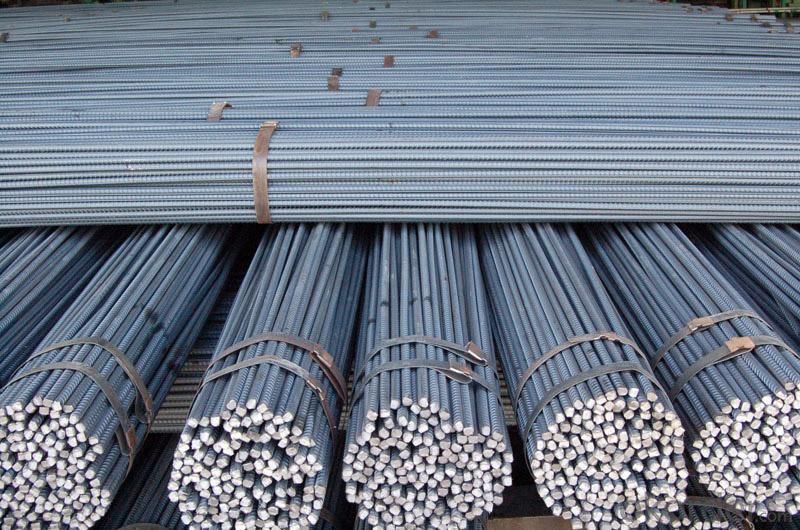

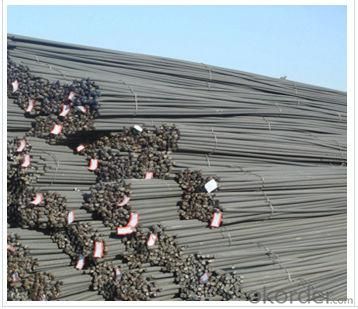
OKorder's deformed steel bar are durable, strong, and resist corrosion.
Main Product Features:
· Premium quality
· Prompt delivery & seaworthy packing (30 days after receiving deposit)
· Corrosion resistance
· Can be recycled and reused
· Mill test certification
· Professional Service
· Competitive pricing
Product Specifications:
Standard | GB | HRB400 | |
Diameter | 6mm,8mm,10mm,12mm,14mm,16mm,18mm,20mm, 22mm,25mm,28mm,32mm,36mm,40mm,50mm | ||
Length | 6M, 9M,12M or as required | ||
Place of origin | Hebei, China mainland | ||
Advantages | exact size, regular package, chemical and mechanical properties are stable. | ||
Type | Hot rolled deformed steel bar | ||
Brand name | DRAGON | ||
Chemical Composition: (Please kindly find our chemistry of our material based on HRB500 as below for your information)
Grade | Technical data of the original chemical composition (%) | ||||||
C | Mn | Si | S | P | V | ||
HRB400 | ≤0.25 | ≤1.60 | ≤0.80 | ≤0.045 | ≤0.045 | 0.04-0.12 | |
Physical capability | |||||||
Yield Strength (N/cm²) | Tensile Strength (N/cm²) | Elongation (%) | |||||
≥400 | ≥570 | ≥14 | |||||
Theoretical weight and section area of each diameter as below for your information:
Diameter(mm) | Section area (mm²) | Mass(kg/m) | Weight of 12m bar(kg) |
6 | 28.27 | 0.222 | 2.664 |
8 | 50.27 | 0.395 | 4.74 |
10 | 78.54 | 0.617 | 7.404 |
12 | 113.1 | 0.888 | 10.656 |
14 | 153.9 | 1.21 | 14.52 |
16 | 201.1 | 1.58 | 18.96 |
18 | 254.5 | 2.00 | 24 |
20 | 314.2 | 2.47 | 29.64 |
22 | 380.1 | 2.98 | 35.76 |
25 | 490.9 | 3.85 | 46.2 |
28 | 615.8 | 4.83 | 57.96 |
32 | 804.2 | 6.31 | 75.72 |
36 | 1018 | 7.99 | 98.88 |
40 | 1257 | 9.87 | 118.44 |
50 | 1964 | 15.42 | 185.04 |
Deformed bar is widely used in buildings, bridges, roads and other engineering construction. Big to highways, railways, bridges, culverts, tunnels, public facilities such as flood control, dam, small to housing construction, beam, column, wall and the foundation of the plate, deformed bar is an integral structure material. With the development of world economy and the vigorous development of infrastructure construction, real estate, the demand for deformed bar will be larger and larger..
Packaging & Delivery of HR Deformed Steel Rebars of Good Quality: Packaging Detail: products are packed in bundle and then shipped by container or bulk vessel, deformed bar is usually naked strapping delivery, when storing, please pay attention to moisture proof. The performance of rust will produce adverse effect. Each bundle weight: 2-3MT, or as required Payment terms: TT payment in advance or Irrevocable LC at sight. Trade terms :FOB, CFR, CIF Delivery Detail: within 45 days after received advanced payment or LC. FAQ: Q1: What makes stainless steel stainless? A1: Stainless steel must contain at least 10.5 % chromium. It is this element that reacts with the oxygen in the air to form a complex chrome-oxide surface layer that is invisible but strong enough to prevent further oxygen from "staining" (rusting) the surface. Higher levels of chromium and the addition of other alloying elements such as nickel and molybdenum enhance this surface layer and improve the corrosion resistance of the stainless material. Q2: Can stainless steel rust? A2: Stainless does not "rust" as you think of regular steel rusting with a red oxide on the surface that flakes off. If you see red rust it is probably due to some iron particles that have contaminated the surface of the stainless steel and it is these iron particles that are rusting. Look at the source of the rusting and see if you can remove it from the surface. |
- Q: What are the different methods of joining steel rebars?
- There is a range of methods available for joining steel rebars, each with its own set of advantages and disadvantages. Here, we present the most common techniques: 1. Lap Splicing: The most widely used method for joining rebars is lap splicing. It entails overlapping two rebars and securing them together with wire or metal ties. This approach is cost-effective and straightforward, but it necessitates longer lap lengths to achieve the required strength. 2. Mechanical Splicing: Mechanical splicing involves connecting rebars using mechanical couplers or splices. These couplers are specifically designed to establish a strong and dependable connection between the rebars. Mechanical splicing enables quicker installation and reduces the need for lengthy overlaps. However, it may be more costly compared to lap splicing. 3. Welding: Another option for joining steel rebars is welding. This process involves heating the rebars and fusing them together using electric arcs or gas flames. Welding creates a robust and permanent connection, but it requires skilled labor and specialized equipment. It is commonly employed in precast concrete applications. 4. Bolted Connections: Bolted connections utilize bolts and nuts to join the rebars. This method offers a flexible and adjustable connection, making it suitable for certain applications. However, bolted connections necessitate additional hardware and may not be as strong as other methods. 5. Adhesive Bonding: Adhesive bonding involves using epoxy or other adhesives to join rebars. The adhesive is applied to the rebars, and they are pressed together until the adhesive cures and forms a strong bond. Adhesive bonding provides a clean and aesthetically pleasing finish, but it may not offer the same level of strength as other methods and is more suitable for non-structural applications. It is essential to consider factors such as specific project requirements, structural design, and construction techniques when selecting a joining method. Consulting with structural engineers and adhering to industry standards and codes is crucial to ensure the appropriate selection and implementation of the joining method for steel rebars.
- Q: How do steel rebars affect the durability of a structure?
- Steel rebars greatly enhance the durability of a structure by providing reinforcement and strength to withstand external forces, such as tension and compression. They improve the structural integrity, increase resistance to cracking and bending, and ensure long-term stability, making the structure more resistant to corrosion and structural failure.
- Q: Are steel rebars suitable for use in sports stadiums and arenas?
- Steel rebars are indeed suitable for use in sports stadiums and arenas. They are extensively utilized in construction due to their exceptional strength and durability properties. In settings such as sports stadiums and arenas, where there is a convergence of large crowds, heavy loads, and utmost concern for safety, steel rebars play a vital role in fortifying the structure. They possess the capacity to endure high tensile forces and prevent bending, making them an ideal choice for reinforcing concrete structures within stadiums and arenas. Moreover, steel rebars exhibit a high resistance to fire, which is of utmost importance in these sprawling public spaces. All in all, steel rebars are a dependable and well-established option for reinforcing sports stadiums and arenas, as they effectively provide the necessary support and meet safety requirements.
- Q: Can steel rebars be used in the construction of sports stadiums or arenas?
- Certainly, the utilization of steel rebars in the construction of sports stadiums or arenas is a viable option. These rebars are frequently employed as reinforcement in concrete structures due to their impressive tensile strength and durability. Their suitability for extensive projects, such as sports stadiums, is evident. By providing extra support and stability, the rebars enable the concrete to withstand the immense loads and forces that occur during events in stadiums and arenas. Moreover, the versatility of steel rebars allows for effortless shaping and bending to match the specific design requirements and needs of the structure, making them an adaptable choice in construction endeavors.
- Q: Are steel rebars suitable for use in historical building restoration?
- Steel rebars can be suitable for use in historical building restoration, but careful consideration should be given to the specific requirements of the project and the significance of the building. Steel rebars offer strength, durability, and ease of installation, which can be advantageous in reinforcing and stabilizing historical structures. However, it is important to ensure that the steel rebars do not compromise the original character and integrity of the building. In some cases, historical buildings may have specific preservation guidelines that prohibit or restrict the use of steel rebars. For instance, if the building is listed as a protected monument, the use of steel rebars may be limited to ensure the preservation of its original materials and construction methods. In such instances, alternative reinforcement materials like timber, stone, or even composite materials may be more appropriate. Additionally, it is crucial to consult with preservation experts, architects, and structural engineers who specialize in historical building restoration. They can provide valuable insights and recommendations on the most suitable reinforcement options for the specific project. Their expertise can help strike a balance between the structural needs of the building and the preservation of its historical value. Ultimately, the suitability of steel rebars for use in historical building restoration depends on a thorough assessment of the building's historical significance, the specific requirements of the restoration project, and adherence to preservation guidelines. With careful planning and consideration, steel rebars can be successfully incorporated into the restoration process, ensuring the longevity and stability of the historical structure while preserving its unique heritage.
- Q: Are there any disadvantages or limitations of using steel rebars?
- Yes, there are some disadvantages or limitations of using steel rebars. Firstly, steel rebars are prone to corrosion when exposed to moisture or harsh environmental conditions, which can weaken the structure over time. Secondly, steel rebars are heavy and require heavy machinery for transportation and installation, making them less suitable for certain construction projects. Additionally, steel rebars can cause electromagnetic interference, which can interfere with electronic devices or communication systems in some cases. Lastly, steel rebars have a high thermal conductivity, which can result in energy losses or thermal bridges if not properly insulated.
- Q: What is the effect of moisture on steel rebars?
- The effect of moisture on steel rebars can lead to corrosion, which weakens the rebars and reduces their structural integrity over time. Moisture can initiate the oxidation process, causing the rebars to rust and potentially compromise the stability of reinforced concrete structures. Regular inspection and maintenance are crucial to prevent and address any moisture-related damage to steel rebars.
- Q: How long do steel rebars last in structures?
- Steel rebars can last for several decades in structures, typically ranging from 50 to 100 years, depending on various factors such as the quality of the steel, environmental conditions, and maintenance practices.
- Q: How are steel rebars used in retaining walls?
- Steel rebars are commonly used in retaining walls to provide additional strength and reinforcement. They are typically placed horizontally within the concrete structure to prevent cracking and improve the wall's structural integrity. The rebars help distribute the load and resist the pressure exerted by the retained soil, ensuring the stability and durability of the retaining wall.
- Q: How are steel rebars cut to specific lengths?
- Steel rebars are cut to specific lengths using heavy-duty tools such as hydraulic shears, manual rebar cutters, or abrasive cutting wheels. These tools provide the necessary force and precision to cut through the strong and dense steel material, allowing rebars to be cut to the desired lengths for construction purposes.
Send your message to us
GR40 deformed steel bar bar for construction
- Loading Port:
- Tianjin
- Payment Terms:
- TT OR LC
- Min Order Qty:
- 10000 m.t.
- Supply Capability:
- 100000 m.t./month
OKorder Service Pledge
OKorder Financial Service
Similar products
Hot products
Hot Searches
Related keywords
